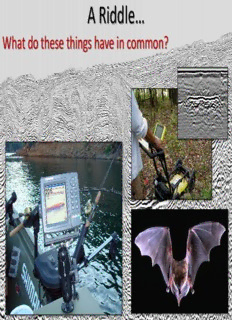
Reflection Seismology - Appalachian State University PDF
Preview Reflection Seismology - Appalachian State University
A Riddle… What do these things have in common? Reflection Seismology Chapter :: 7 The Seismic Reflection Method: A dynamic geophysical technique of generating a sound wave at a source and recording the time it takes for components of that seismic energy to return to the surface and be recorded by receivers Ground Penetrating Radar: Utilizes similar theory, but the source is electromagnetic waves Images Courtesy John Shaw, Harvard University Seismic Reflection Things to know before we start… • Seismic reflection is the single most important technique for – seeing into the Earth. • It is useful for shallow and deep depths • Massively used by the oil and gas industry • It can detect: – Stratigraphy – Faults – Folds – Oil & Gas Reservoirs – Groundwater Resources Why so popular? – • Produces results that actually look a lot like an actual geologic cross section!! Salt Dome: Gulf of Mexico Reflection Seismology 1920’s - 1930’s, seismic reflection developed for oil/gas • exploration in sedimentary basins. Since 1970’s, valuable in understanding structure of • mid-lower crust. Popular for three main reasons: • Reflection data is commonly portrayed as profile resembling – “geologic cross sections”. Offers high resolution of subsurface data. – Cheaper than blindly drilling – Refraction vs. Reflection So, what are the main take-home differences between these • two seismic techniques? Refraction Reflection Resolves gross crustal Resolves fine subsurface velocities details critical refraction requires requires a change in v or large v gradient density X=5-10x the depth of X=1x the depth of interest interest Processing is relatively Processing can be very easy CPU intensive ~30% of global CPU time is spent on processing seismic reflection data http://pangea.stanford.edu/~sklemp/bering_chukchi/reflection.html Seismic Reflection :: The Basics In the simplest sense • seismic reflection is echo sounding. Echoes come from layers in – the Earth, not fish or the sea floor E.g. a ship sends out a • seismic pulse The pulse is reflected back to – a receiver on the ship’s bottom after some time has passed The various arrivals can be – used to map out subsurface “reflectors” or layers Seismic Reflection Caveats 1. The vertical scale on seismic reflection profiles is time, not depth Velocity varies with depth, so time cannot be easily converted – to depth 2. Reflections may not come from directly below the source Reflections occur perpendicular to the interface. Receivers / – Geophones / Seismometers cannot directly detect this. 3. There may be multiple reflections off of single interfaces Called multiples – 4. There are other caveats, but we’ll deal with these later Non-Vertical Reflection Reflected rays travel back to the source following a path • perpendicular to the interface The receiver will record an arrival time that is too short and a – dip that is too shallow We’ll talk more about this later… – Multiples On their return to the surface… • Reflected rays can also reflect back down and then later be – reflected back up This causes a single reflector to potentially produce • several “multiples” Short path (less • reflections) multiples are usually stronger These artifacts can • be removed by migration • We’ll talk about migration later… Multiples in a Seismic Section The sea floor is commonly a strong reflector So it commonly produces multiples
Description: